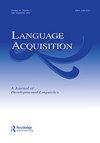Language Acquisition 期刊简介

Language acquisition is the process by which humans acquire the capacity to perceive and comprehend language (in other words, gain the ability to be aware of language and to understand it), as well as to produce and use words and sentences to communicate. Language acquisition involves structures, rules and representation. The capacity to successfully use language requires one to acquire a range of tools including phonology, morphology, syntax, semantics, and an extensive vocabulary. Language can be vocalized as in speech, or manual as in sign. Human language capacity is represented in the brain. Even though human language capacity is finite, one can say and understand an infinite number of sentences, which is based on a syntactic principle called recursion. Evidence suggests that every individual has three recursive mechanisms that allow sentences to go indeterminately. These three mechanisms are: relativization, complementation and coordination.[1] There are two main guiding principles in first-language acquisition: speech perception always precedes speech production and the gradually evolving system by which a child learns a language is built up one step at a time, beginning with the distinction between individual phonemes.[2] Linguists who are interested in child language acquisition for many years question how language is acquired, Lidz et al. states "The question of how these structures are acquired, then, is more properly understood as the question of how a learner takes the surface forms in the input and converts them into abstract linguistic rules and representations."[3] Language acquisition usually refers to first-language acquisition, which studies infants' acquisition of their native language, whether that be spoken language or signed language as a result of prelingual deafness. This is distinguished from second-language acquisition, which deals with the acquisition (in both children and adults) of additional languages. In addition to speech, reading and writing a language with an entirely different script compounds the complexities of true foreign language literacy. Language acquisition is one of the quintessential human traits,[4] because non-humans do not communicate by using language.
语言习得是人类获得感知和理解语言的能力(换句话说,获得感知和理解语言的能力),以及产生和使用词汇和句子进行交流的过程。 语言习得包括结构、规则和表达。成功使用语言的能力需要获得一系列工具,包括音位学、形态学、句法、语义和广泛的词汇。语言可以在言语中发声,也可以在手语中手动发声。人类的语言能力表现在大脑中。即使人类的语言能力有限,人们也可以说和理解无限多的句子,这是基于一种称为递归的句法原理。有证据表明,每个人都有三种递归机制,允许句子不确定地进行。这三种机制是:相对化、互补和协调。 在第一语言习得中,有两个主要的指导原则:言语感知总是先于言语产生,而儿童学习语言的逐渐进化的系统是从个体音素之间的区别开始逐步建立起来的。 对儿童语言习得感兴趣多年的语言学家质疑语言是如何习得的,Lidz等人陈述“那么,如何获得这些结构的问题,更恰当地理解为学习者如何在输入中采用表面形式并将其转化为抽象的语言规则和表示的问题。” 语言习得通常指的是第一语言习得,研究婴儿对母语的习得,无论是语言前聋导致的口语或手语。这与第二语言习得不同,第二语言习得涉及(儿童和成人)其他语言的习得。除了语言,阅读和书写一种完全不同的语言文字,使真正的外语识字能力更加复杂。语言习得是人类的典型特征之一,因为非人类不通过语言进行交流。
|
期刊ISSN
|
1048-9223 |
|
影响指数
|
1.336 |
|
最新CiteScore值
|
0.00 查看CiteScore评价数据 |
|
最新自引率
|
12.10% |
|
官方指定润色网址
|
https://www.deeredit.com/?type=ss1 |
|
投稿语言要求
|
Improve the quality of the paper, eliminate grammar and spelling errors, increase readability, ensure accurate communication of viewpoints, enhance academic reputation, and increase the chances of the paper being accepted. 建议点击这个网址:https://www.deeredit.com/?type=ss2,资深审稿专家为您评估稿件质量,提供针对性改进建议,最终可助您极大提升目标期刊录用率 |
|
期刊官方网址
hot |
https://www.peipusci.com/?type=9 |
|
杂志社征稿网址
hot |
https://www.peipusci.com/?type=10 |
|
通讯地址
|
|
|
偏重的研究方向(学科)
|
Multiple- |
|
出版周期
|
|
|
出版年份
|
0 |
|
出版国家/地区
|
|
|
是否OA
|
0 |
|
SCI期刊coverage
|
Science Citation Index Expanded(科学引文索引扩展) |
|
NCBI查询
|
PubMed Central (PMC)链接 全文检索(pubmed central) |
|
最新中科院JCR分区
|
大类(学科)
小类(学科)
综述期刊
人文科学
LINGUISTICS (语言学)4区
否
|
|||||
|
最新的影响因子
|
1.336 | |||||
| 最新公布的期刊年发文量 |
|
|||||
| 总被引频次 | 0 | |||||
| 影响因子趋势图 |
近年的影响因子趋势图(整体平稳趋势)
|
|||||
2022年预警名单预测最新

|
最新CiteScore值
|
0.00
|
||
| 年文章数 | 25 | ||
|
SJR
|
|||
|
SNIP
|
|||
| CiteScore趋势图 |
CiteScore趋势图
|
||
|
本刊同领域相关期刊
|
|
| 期刊名称 | IF值 |
| COMPUTATIONAL LINGUISTICS | 2.248 |
| Natural Language Engineering | 1.059 |
| Journal of Linguistic Anthropology | 1.853 |
| Argumentation | 1.078 |
| LANGUAGE & COMMUNICATION | 1.747 |
| Interaction Studies | 0.816 |
| Social Semiotics | 1.307 |
| Translator | 0.572 |
| Text & Talk | 0.502 |
|
本刊同分区等级的相关期刊
|
|
| 期刊名称 | IF值 |
| Journal of Linguistic Anthropology | 1.853 |
| MODERN LANGUAGE JOURNAL | 4.711 |
| TESOL QUARTERLY | 3.655 |
| Language Teaching | 5.274 |
| ReCALL | 2.888 |
| LANGUAGE LEARNING & TECHNOLOGY | 4.27 |
| Language Teaching Research | 3.86 |
| Computer Assisted Language Learning | 4.741 |
| Assessing Writing | 2.329 |
| 分享者 | 点评内容 |





